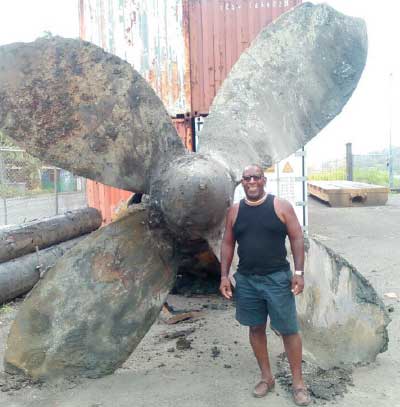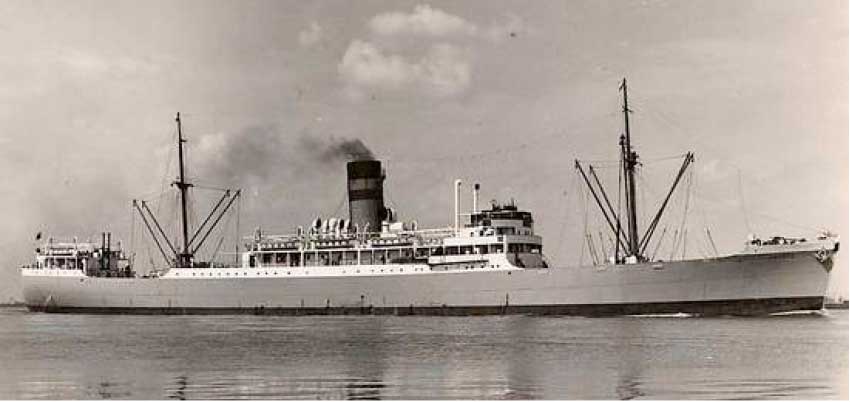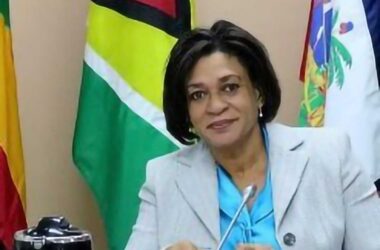MASTER mariner Michael Chastanet recently penned a nostalgic piece in The VOICE about the huge propeller unearthed in the Castries Harbour. Like everybody else, he immediately identified it as the propeller of the Lady Nelson, one of two ships torpedoed here by a German submarine in March 1942. Mr. Chastanet admitted he never thought he’d lived to see the propeller, far less touch it – and ensured he recorded the moment for posterity.

Most his age can still actually remember hearing the giant explosions that fateful day. It was in the middle of World War II (1939-45) and the Germans operated from nearby Martinique with the collusion of the Vichy regime.
After the two ships were torpedoed, Castries residents were officially advised to move to the hills for safety, because the town was under attack by German ‘U-Boats’. Also in the harbour at the time was the Umtata, a ‘steam merchant’ type of vessel (8,141 tonnes gross) built in England in 1935 and registered in Calcutta, India.
According to uboat.net: “At 4.49 a.m. on 10 March 1942, U-161 fired two torpedoes into the harbour of Port Castries, St. Lucia. The first torpedo hit the Lady Nelson which caught fire and sank by the stern in shallow waters.
Senior SLASPA Marine Pilot Guy Bousquet has fond memories of his late dad Pilot Charles Bousquet’s stories about what happened the day the Umtata and Lady Nelson were torpedoed in Castries.
“The second torpedo struck the Umtata, which also sank by the stern.
“The vessel was en route “from Durban to New York with a cargo of chrome ore, asbestos and meat”, altogether 2,000 tons of mineral ore.
“However, both vessels were later salvaged and repaired.”
“On 2 May, she (Umtata) was salvaged, temporarily repaired and then sunk by another U-boat while under tow to Port Everglades, for permanent repairs.”
As fate would have it, Umtata was torpedoed twice – and in the same year, within weeks.
According to the same quoted account: “At 9.02 a.m. on 7 July 1942, the Umtata (captained by Master R. Owen Jones) was torpedoed and sunk by U-571 (captained by Helmut Möhlmann) northeast of Key West in the Florida Strait, while under tow by the American tug Edmund J. Moran…
“The Master and 91 crew members were picked up by the tug, transferred to USCGC Thetis (WPC 115) and landed at Miami.”
I don’t want to be a bad news scrooge or anything like that, but some interesting facts emerge from the above accounts that lead me to ask more questions about the giant propeller – and which of the two ships it belongs to, if any.
First, it was one submarine, not two, that fired the two torpedoes on March 10, 1942 in Castries. However, another torpedoed the Umtata the second and last time in July. As a result of the Castries boat bombings, lives were lost on both ships — and on the Castries docks:
Three crew members (out of 116), 15 passengers (out of 110) and two gunners died on the Lady Nelson, along with seven dock workers; and in the case of the Umtata, four (of the 140 crew members), four gunners and 33 passengers died.
Secondly, both ships were eventually floated and left the harbour to be repaired overseas:
On April 16, Lady Nelson was “salvaged, temporarily repaired and left for Mobile (Alabama) on May 11”. It was later converted to a hospital ship for 518 patients and commissioned on April 22, 1943; and some ten weeks later (on July 7, 1943) the Umtata was sunk while being towed to Florida from Castries.

Thirdly, the names of the submarines and commanders involved in attacks in Saint Lucia are all available: the first sub that torpedoed Castries was U-161, captained by Albrecht Achilles; the U-571 that sank the Umtata for good was captained by Helmut Möhlmann and the U-66 that mined the Castries harbour was captained by Freidrick Markworth,
There’s an interesting account in the book ‘A History of Saint Lucia’ (Harmsen, Ellis & Devaux) about the third German U-Boat captain.
Markworth brought his U-66 sub right up to a steel net across the Castries harbour (partly built by St. Mary’s College students) and laid mines that exploded two small crafts, leading to immediate mine-sweeping of all Caribbean harbours under British and American control.
The book also reveals that Achilles and Markworth were among a couple hundred German naval students in training who visited Saint Lucia in May 1939 aboard a German training ship named Gorch Fock.
But while they praised the island to the hilt, it would emerge that they were actually taking photographs of naval and air stations in Saint Lucia, gathering information that later became important to Germany – and themselves – during the war that soon started.
It will be difficult to say the giant propeller found here did not belong to either of the two torpedoed boats. But no proof has yet been presented as to which, or if any.
Finding the proof should not be hard: like checking the available records of the companies that built them to specify the size; or, identifying certain engraved markings on the huge propeller and shaft.
But while I hear and accept all the calls for preserving the propeller for history, we have to first get the history behind this interesting find – which I am sure the likes of the Archeological and Historical (A&H) Society, the National Trust, the National Archives and interested persons and entities can adopt as an immediate project of interest.
Meanwhile, there’s another historical fact I would like to see unearthed.
I have all my life remembered reading a ‘Letter to the Editor’ in The Voice of Saint Lucia while growing up, written by someone who may have claimed to have had authority (even a captain) of one of the submarines that torpedoed ships in and from Castries.
It was in the early-to-mid-60s (or possibly a little later) and the German letter writer had now visited Castries as a tourist; and before leaving he posted or delivered the letter to The Voice, in which he offered sincere apologies.
I cannot quite remember if his name was published, but the letter (which exists in the Voice archives) is proof that whoever it was, he came back here to offer remorse – and I always wished I could have contacted him or his family, whether Achilles, Mohlmann or Markworth.
Mr. Chastanet also referred to the large hand-made net placed across the harbour’s entrance – from Tapion to Vigie — after the two ships were torpedoed in 1942.
I also remember being told (by local seamen and associated so-called ‘Wharf Rats’ who were likely to know) that the net was also guarded by a popular gentleman better known as “Tortie” (father of Martin von Fritsche and the rest of the Fritsche clan), whose turtle business was near the said net at Tapion (where a prominent and artistic family member still resides).
Then there is also the claim by oral historians that there exists a deep underwater tunnel across the entrance of the Castries harbour, also from Tapion to Vigie, which was used in earlier wars to transfer troops and armaments from Morne Fortune to the Vigie cannon outposts, military barracks and the lighthouse.
I never saw the net or the tunnel, but in pursuit of the true history of the propeller, might we not as well add them both to the new chapters of the history of Saint Lucia that will emerge when the truth is found and chronicled?
And wouldn’t it be good to get the names of the seven Castries dock workers who died in the Lady Nelson and Umtata attacks, so that their families could also be identified for the official records being kept by the likes of uboat.net?












Whose Propeller
Dear Sir
I read your article with interest recently on the Umtata and Lady Nelson. I have received information on the Lady Nelson which your readers may be interested in.
I contacted Camel Laird who built the Ladyy Nelson. They referred me to Wirral Archives Service as they now hold Camel Laird shipping records. Wirral stated that the Lady Nelson lost both her propellers and rudder when torpedoed. This information was obtained from THE LADY BOATS a book by FELICITY HANINGTON(1980) they said.
Wirral also say that info.from ENGINE DRAWING OFFICE DATA BOOK (ref.ZCL4/5/9) give details on the propellers–they were FOUR BLADED and of MANGANESE BRONZE exactly 14 FEET in DIAMETER . So if your propeller is 14 feet across it is probably I emphasise probably from the Lady Nelson
From: Archives
Date: 19 June 2017 at 14:14:05 BST
To: anthony degazon
Subject: (E2017/175) Lady Nelson propeller
Dear Mr Degazon,
Thank you for your enquiry and photographs concerning whether the propeller recovered recently from Castries Harbour, St Lucia, is from the Lady Nelson, built by Cammell Laird (vessel number 938).
The Lady Nelson lost both her propellers and her rudder when she was torpedoed, according to The Lady Boats: The Life and Times of Canada’s West Indies Merchant Fleet by Felicity Hanington (1980). This book also has a photograph of the remains of her sister ship the Lady Rodney (later the Mecca), which shows a propeller – please find a scan of this photograph attached.
We don’t have a record of any identity number I am afraid but the Engine Drawing Office data book (ref ZCL 4/5/9) does give information on the propellers – they were four bladed and of manganese bronze, exactly 14 feet in diameter – no other Cammell Laird ship of that period had that propeller size. So if your propeller is exactly 14 feet across it is probably from the Lady Nelson.
Yours sincerely,
Will Meredith
William Meredith
Archivist
Wirral Archives Service
Keep the history alive. The event happened before I was born ,however, I have heard of the incident and have always yearned for information on this historical event.